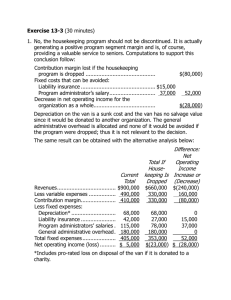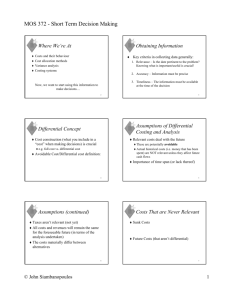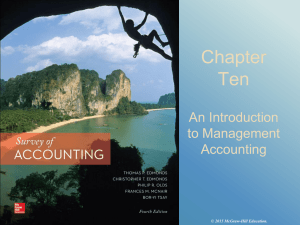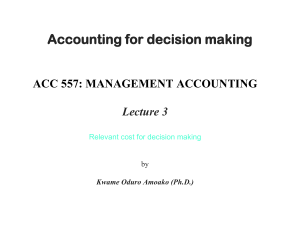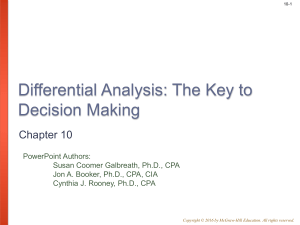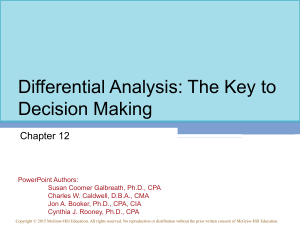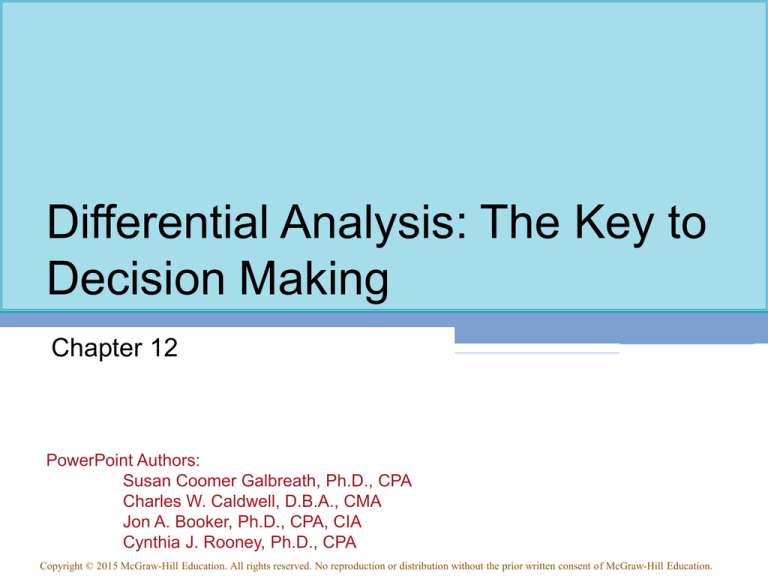
Differential Analysis: The Key to
Decision Making
Chapter 12
PowerPoint Authors:
Susan Coomer Galbreath, Ph.D., CPA
Charles W. Caldwell, D.B.A., CMA
Jon A. Booker, Ph.D., CPA, CIA
Cynthia J. Rooney, Ph.D., CPA
Copyright © 2015 McGraw-Hill Education. All rights reserved. No reproduction or distribution without the prior written consent of McGraw-Hill Education.
12-2
Relevant Costs and Benefits
A relevant cost is a cost that differs
between alternatives.
A relevant benefit is a benefit that
differs between alternatives.
12-3
Identifying Relevant Costs
An avoidable cost is a cost that can be
eliminated, in whole or in part, by choosing
one alternative over another. Avoidable costs
are relevant costs. Unavoidable costs are
irrelevant costs.
Two broad categories of costs are never
relevant in any decision. They include:
Sunk costs.
A future cost that does not differ between
the alternatives.
12-4
Decision Making: A Two-Step Process
Step 1 Eliminate costs and benefits that do not differ
between alternatives.
Step 2 Use the remaining costs and benefits that
differ between alternatives in making the
decision. The costs that remain are the
differential, or avoidable, costs.
12-5
Total and Differential Cost Approaches
The management of a company is considering a new labor saving
machine that rents for $3,000 per year. Data about the company’s
annual sales and costs with and without the new machine are:
Sales (5,000 units @ $40 per unit)
Less variable expenses:
Direct materials (5,000 units @ $14 per unit)
Direct labor (5,000 units @ $8 and $5 per unit)
Variable overhead (5,000 units @ $2 per unit)
Total variable expenses
Contribution margin
Less fixed expense:
Other
Rent on new machine
Total fixed expenses
Net operating income
Current
Situation
$
200,000
Situation
With New
Machine
$
200,000
Differential
Costs and
Benefits
-
70,000
40,000
10,000
120,000
80,000
70,000
25,000
10,000
105,000
95,000
15,000
15,000
62,000
62,000
18,000
62,000
3,000
65,000
30,000
(3,000)
(3,000)
12,000
$
$
12-6
Total and Differential Cost Approaches
As you can see, the only costs that differ between the
alternatives are the direct labor costs savings and the
increase in fixed rental costs.
Current
Situation
$
200,000
Situation
With New
Machine
$
200,000
Sales (5,000 units @ $40 per unit)
Less variable expenses:
We
canunits
efficiently
analyze the
decision 70,000
by
Direct materials
(5,000
@ $14 per unit)
70,000
Direct labor looking
(5,000 units at
@ $8
anddifferent
$5 per unit) costs 40,000
25,000
the
and revenues
Variable overhead (5,000 units @ $2 per unit)
10,000
10,000
and
arrive
at
the
same
solution
Total variable expenses
120,000
105,000
Contribution margin
80,000
95,000
Net Advantage to Renting the New Machine
Less fixed expense:
Decrease in direct labor costs (5,000 units @ $3 per unit)
$
15,000
Other
62,000
62,000
Increase in fixed rental expenses
(3,000)
Rent on newNet
machine
3,000
annual cost saving from renting the new machine
$
12,000
Total fixed expenses
62,000
65,000
Net operating income
$
18,000
$
30,000
.
Differential
Costs and
Benefits
15,000
15,000
(3,000)
(3,000)
12,000
12-7
Adding/Dropping Segments
One of the most important
decisions managers make
is whether to add or drop a
business segment.
Ultimately, a decision to
drop an old segment or
add a new one is going to
hinge primarily on the
impact the decision will
have on net operating
income.
To assess this
impact, it is
necessary to
carefully analyze
the costs.
12-8
Adding/Dropping Segments
Due to the declining popularity of
digital watches, Lovell Company’s
digital watch line has not reported a
profit for several years. Lovell is
considering discontinuing this
product line.
12-9
Adding/Dropping Segments
Segment Income Statement
Digital Watches
Sales
Less: variable expenses
Variable manufacturing costs
Variable shipping costs
Commissions
Contribution margin
Less: fixed expenses
General factory overhead
Salary of line manager
Depreciation of equipment
Advertising - direct
Rent - factory space
General admin. expenses
Net operating loss
$ 500,000
$ 120,000
5,000
75,000
$ 60,000
90,000
50,000
100,000
70,000
30,000
200,000
$ 300,000
400,000
$ (100,000)
12-10
A Contribution Margin Approach
Contribution Margin
Solution
Contribution margin lost if digital
watches are dropped
Less fixed costs that can be avoided
Salary of the line manager
$
90,000
Advertising - direct
100,000
Rent - factory space
70,000
Net disadvantage
$ (300,000)
260,000
$ (40,000)
12-11
The Make or Buy Decision
When a company is involved in more than one
activity in the entire value chain, it is
vertically integrated. A decision to carry out
one of the activities in the value chain
internally, rather than to buy externally from
a supplier is called a “make or buy” decision.
12-12
The Make or Buy Decision: An
Example
Essex Company manufactures part 4A that is used
in one of its products. The unit product cost of this
part is:
Direct materials
Direct labor
Variable overhead
Depreciation of special equip.
Supervisor's salary
General factory overhead
Unit product cost
$
9
5
1
3
2
10
$ 30
12-13
The Make or Buy Decision
Cost
Per
Unit
Outside purchase price
$ 25
Direct materials (20,000 units)
Direct labor
Variable overhead
Depreciation of equip.
Supervisor's salary
General factory overhead
Total cost
$
9
5
1
3
2
10
$ 30
Cost of 20,000 Units
Buy
Make
$ 500,000
180,000
100,000
20,000
40,000
$ 340,000
$ 500,000
The avoidable costs associated with making part 4A include direct
materials, direct labor, variable overhead, and the supervisor’s salary.
12-14
The Make or Buy Decision
Cost
Per
Unit
Outside purchase price
$ 25
Direct materials (20,000 units)
Direct labor
Variable overhead
Depreciation of equip.
Supervisor's salary
General factory overhead
Total cost
$
9
5
1
3
2
10
$ 30
Cost of 20,000 Units
Buy
Make
$ 500,000
180,000
100,000
20,000
40,000
$ 340,000
$ 500,000
Should we make or buy part 4A?
Given that the total avoidable costs are less than the cost of
buying the part, Essex should continue to make the part.
12-15
Opportunity Cost
An opportunity cost is the benefit that is
foregone as a result of pursuing some
course of action.
Opportunity costs are not actual cash outlays
and are not recorded in the formal accounts
of an organization.
12-16
Key Terms and Concepts
A special order is a one-time
order that is not considered
part of the company’s normal
ongoing business.
When analyzing a special
order, only the incremental
costs and benefits are
relevant.
Since the existing fixed
manufacturing overhead costs
would not be affected by the
order, they are not relevant.
12-17
Key Terms and Concepts
When a limited resource of
some type restricts the
company’s ability to satisfy
demand, the company is
said to have a constraint.
The machine or
process that is
limiting overall output
is called the
bottleneck – it is the
constraint.
12-18
Joint Costs
• In some industries, a number of end
products are produced from a single raw
material input.
• Two or more products produced from a
common input are called joint products.
• The point in the manufacturing process
where each joint product can be
recognized as a separate product is
called the split-off point.
12-19
Sell or Process Further
Joint costs are irrelevant in decisions regarding
what to do with a product from the split-off point
forward. Therefore, these costs should not be
allocated to end products for decision-making
purposes.
With respect to sell or process further decisions, it is
profitable to continue processing a joint product
after the split-off point so long as the incremental
revenue from such processing exceeds the
incremental processing costs incurred after the
split-off point.
12-20
End of Chapter 12



